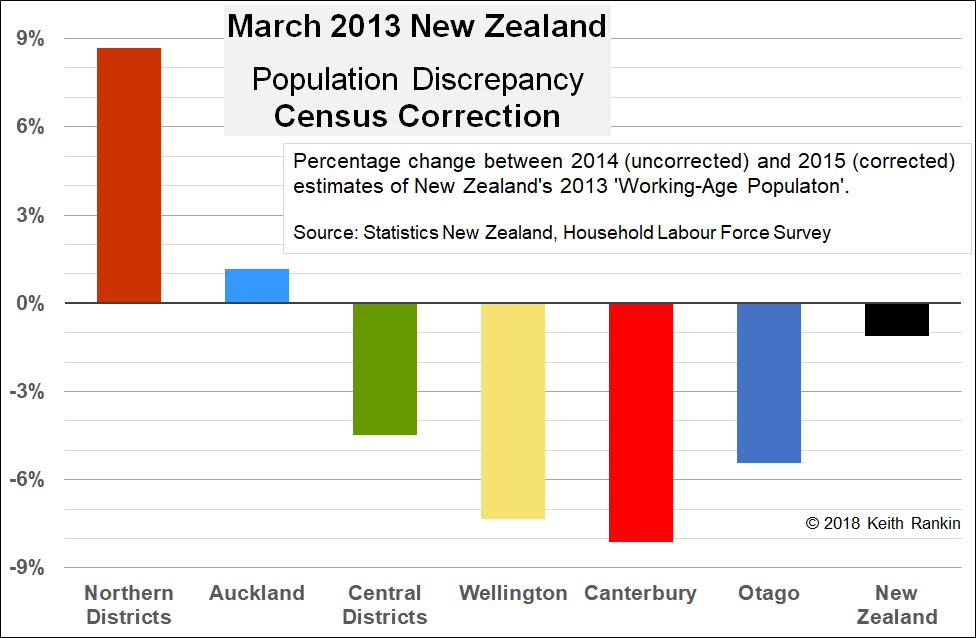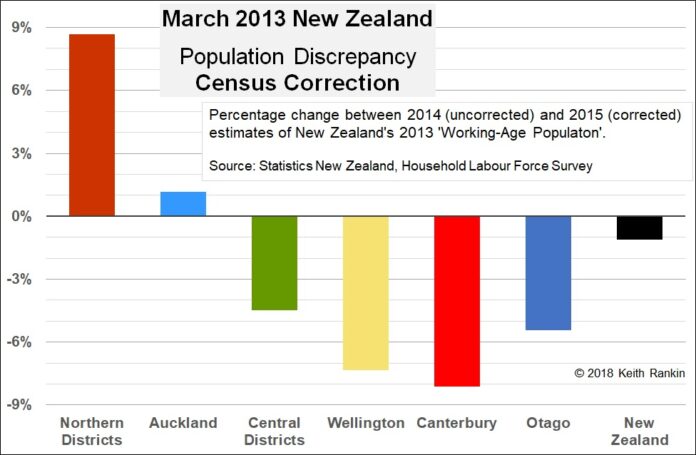Political Roundup: The 2018 census debacle and its consequences
Exactly a year ago, on 6 March 2018, the government census was carried out. It was a “digital-first” census, with citizens expected to primarily use the internet to answer the compulsory questions about their lives. And it was soon apparent that huge numbers of New Zealanders had been missed out by the exercise – likely to be at least one in ten.

But we are only now finding out how much of a debacle that event was, along with increasing knowledge of the seriously negative implications for our society and democracy. And to make matters worse, there’s a distinct lack of political or bureaucratic accountability for what has happened.
A number of newspaper stories have been published today about the anniversary of the 2018 census debacle. The most important is Thomas Manch’s 365 days and still counting: Census 2018 results nowhere to be seen. In this, he explains that “The 2018 census data release has been delayed three times due to low response rate” and “Statistics New Zealand remains tight-lipped about when the long-delayed results will be available”.
The article explains that the census operation resourcing was inadequate, especially in terms of the number of field staff hired to help people get their census filled out: “Newly released information shows Stats NZ employed 1800 enumerators, or field staff, to knock on doors and uncover those who failed to complete Census 2018. This was a substantial drop from the 7000 boots on the ground during Census 2013”.
A number of economists and statisticians explain the growing awareness of the severity of the “shambolic” census operations. For example, University of Auckland statistician Andrew Sporle is quoted saying: “It’s a bit of a disaster, we don’t know how bad, but we know it’s a disaster.”
Sporle explains that the data, once it’s eventually released, “will provide increased uncertainty in matters from the Government’s wellbeing targets to the number of Māori electorates.”
Manch looks at the Māori electorates in another article today, Māori electorate seat at risk due to Census 2018 debacle, and says that, due to the way Statistics NZ have run the census, there are likely to be much fewer respondents reporting that they are of have Māori descent, which could lead to one of the Māori seats disappearing.
One specialist is cited as saying that although the 2018 census participation rate is estimated to be about 90 percent for the general population, “the response rate of Māori may be as low as 80 or 70 per cent in some corners of New Zealand”. In addition, “more than 20 new iwi won’t be properly counted” in the census, and this is a problem because “census data was particularly important for smaller iwi trying to do good with fewer resources”.
Societal consequences of the census debacle
There are plenty of other serious implications if the census 2018 data is unreliable, as is increasingly expected. For example, planning and funding for health and education is highly reliant on this population data, and some hospitals and schools might receive inadequate resourcing as a result. Much of this is explained in Cate Broughton’s article today, Health boards, schools may lose funding as Ministries forced to use 2013 census data.
In this, University of Otago’s health systems expert Robin Gauld explains how hospitals might be negatively impacted: “It could have fairly profound implications for a DHB off a $1 billion dollar budget – if you’re a per cent or two off, that’s $10 or $20 million dollars, the difference between surplus and deficit.”
The article points out that this is likely to have a particularly adverse impact on poorer communities, with Child Poverty Action Group’s Alan Johnson quoted: “What you will get in places like South Auckland is there might be 10,000 – 15,000 people missing from the count – well the DHB won’t be getting funded for them so them and everyone else in that area will struggle with less funding.”
Currently the problems with the census data means that government departments are having to rely on 2013 census data. In terms of schools, the president of NZEI, Lynda Stuart, says: “If they are looking at using 2013 census data then yes potentially schools’ [funding levels] could stay the same and yet communities do change so it’s obviously highly problematic”.
So will the census debacle have a negative impact on social wellbeing? Certainly, the Government is making much of putting “wellbeing” at the centre of Grant Robertson’s upcoming Budget, but there must be questions as to the credibility of an approach that emphasises the need to measure social indicators when measures are so inadequate.
Furthermore, the Government has admitted that Robertson’s Budget won’t make use of the latest data: “Crucial funding decisions in Budget 2019 will be made without data from Census 2018” – see Thomas Manch’s Census data won’t make Budget 2019. National’s finance spokesperson, Amy Adams, says that this is “highly unusual”, but the Government has claimed that they never intended to use the new census data in the Budget.
Adams has also asked whether hospitals and schools which receive inadequate funding based on old data will eventually have their correct funding restored and backdated once the new data arrives.
Electoral consequences of the census debacle
The other major census headache is the upcoming general election, which is constitutionally-mandated to be run on the basis of electorate boundaries being redrawn in light of the census. The exercise of the boundary re-drawing is carried out by the Representation Commission (which effectively involves the Electoral Commission and representatives of the Labour and National parties). But if they don’t have access to the latest census data, or if the census data is deemed unreliable, then the whole exercise could collapse or lead to messy court proceedings.
This is best covered by Henry Cooke in his article, Statistics New Zealand confident census data will be ready for 2020 election boundaries. In this, National’s Electoral Reform spokesman Nick Smith challenges the robustness of the likely census data for the election, and says: “It is totally unsatisfactory to be determining electorate boundaries that can effectively determine who will be the next Government on the basis of guesswork”.
If National doesn’t have confidence in the census data being used to re-draw the electorates then the party could take legal action or simply pull out of involvement in the Representation Commission, which would collapse the whole process. This article says that National want the 2013 census data to be used instead, and “National was not ruling out ‘alternative action’ if this did not happen”.
A big issue is the matter of when Statistics NZ manages to get the data to the Electoral Commission, which is currently unknown. National’s David Farrar explains the problems with the timetable: “This would normally have been September 2018, so we’d have new boundaries by March 2019 – well before the election. If Stats NZ can’t release census data before say December 2019, then we’d have final boundaries in June 2020. That would be a disaster. Selections would have occurred by then. You can’t change boundaries just three months before an election. Parliament would probably have to legislate to delay the new boundaries until after the 2020 election. Ideally new boundaries should be finalised before election year. That means Stats NZ really needs to get the data out by June 2019. Any later than that and it will create a real headache for the boundaries review” – see: The census disaster gets worse.
Blame game and unaccountability
Given the anniversary of the 2018 census debacle, there is now a renewed interest in working out exactly what went so wrong a year ago and who is to blame. Journalists have had great trouble getting answers on any of this, because both the Government and Statistics New Zealand have been uncooperative and uncommunicative about what has happened.
But with the help of the Official Information Act, Newsroom’s David Williams has accessed 189 pages of information from Statistics New Zealand, which help illustrate the process during which the disaster unfolded – see his must-read account of “a digital-first experiment gone wrong”: Bungled, costly census to produce less ().
Williams has also been seeking comment from officials and politicians. He says “Stats NZ said no one was available for an interview.” And the Minister of Statistics James Shaw is asked “about his confidence in the integrity of the census data”, to which he rather weasily replies: “I am confident Stats NZ is making every effort and applying as many options as possible to deliver robust Census data.”
And a Statistics New Zealand official is interviewed, who says: “There is no accountability or responsibility being taken internally for what is turning out to be the worst census in over 50 years.”
For a very in-depth and interesting account of the census debacle, see the Otago Daily Times feature story, And then there were nine, by Bruce Munro, which was published in the weekend. This is, so far, the ultimate exploration of what went wrong.
Kathy Connolly, Stats NZ’s census general manager, answers questions put to her about whether the debacle was a result of the previous National Government running down the public service and replies “no comment”. Was the debacle due to Stats NZ being asked to “Go do a cheap census”? Again: “No further comment”.
There is also great debate in the article between Labour and National politicians about underfunding and oversight. They both blame each other, of course.
Munro also reports: “What exactly happened is hotly debated, but not loudly. Most of those close to the action will not talk on the record. At an operational level, when it came to rolling out New Zealand’s first largely online census, several wheels fell off, they say. There wasn’t enough publicity. Statistics New Zealand relied on the diminished postal system to get initial information to people. There were not enough forms. Fewer people were employed to follow up on those who had not filled out their form.”
In the end, the results of the census debacle are likely to impact negatively on the marginalised of society. In this regard, the views of the University of Otago’s professor of public health, Peter Crampton, are reported: “those for whom good social policy is of the highest priority” will be undercounted. The result will be a worsening of their position: “If these groups become invisible in the census then policy-making becomes doubly difficult and some of the least advantaged communities are at risk of becoming further marginalised.”
The decision by Statistics New Zealand to slash the number of census field workers is “beyond comprehension” according to economist Brian Easton – see his opinion piece today: Census mess can be resolved with a new one in 2021. But Easton argues that it’s quite feasible for the Government to get a robust new census up and running for the early date of 2021.
Finally, have Statistics NZ staff been spending too long “checking their privilege” instead of checking the pulse of the nation? Just before Christmas it was discovered that the government agency had their staff carry out a game to determine who was ‘white’, ‘Christian’, ‘able-bodied’, ‘male’, ‘heterosexual’ and had ‘no speech impediment’ – see Dan Satherley’s Stats NZ defends hosting ‘Check Your Privilege Bingo’ game.







